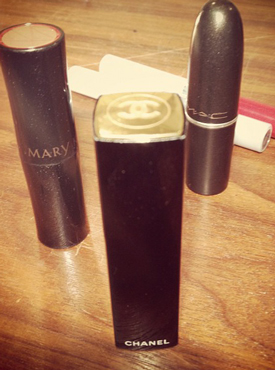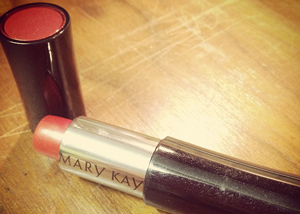My best friend used to buy $1 lipstick when we were in high school. I think she still does.
 Her logic: “If I only pay a dollar for it, I can have lots of different ones. And I don’t have to fret about losing it or having it melt in the car.”
Her logic: “If I only pay a dollar for it, I can have lots of different ones. And I don’t have to fret about losing it or having it melt in the car.”
Like a good friend, I went along with this logic.
For years.
Is expensive lipstick really expensive?
I’m not here to convince you of the quality of expensive lipstick. There are blogs out there dedicated to lipstick. I’m merely a serious lipstick user.
I will, however, attempt to convince you of the math (economics?) in lipstick.
There’s some psychology in this.
Suppose you buy your own lipstick (which you probably do). If you pay $1 for it, the perceived value is quite low – regardless of the actual quality. And you treat it like that – leaving it in the car to melt, forgetting it in a public restroom, etc.
Just like my friend does.
Now let’s assume that you pay $10 for a tube of lipstick. That’s ten times what you’ve been paying.
All of a sudden the perceived value is huge!
The loss factor is indirectly proportional to the price of the lipstick!
If you pay ten times as much for a tube of lipstick, you’re 1/10 as likely to lose it. Okay, I have no empirical evidence to confirm this, merely empirical experience.

But it’s true!
As soon as I started buying expensive lipsticks, I quit losing them. And I quit leaving them in the car to be melted by the Houston heat!
Note for my mathematician friends – the constant of proportionality is affected by the lipstick wearer and that crazy butterfly down in South America. There’s not strict math here. Yet. 😀
The finish-factor is directly proportional to the price of the lipstick.
Not only do I keep an expensive tube much longer, but I tend to finish it. In fact, the more expensive it is, the more likely I’ll use a lip brush to dig out the stuff crammed deep in the tube!
My current favorite, Chanel Allure Rouge, is a shocking $30 per tube. I keep the old broken tube in the Math Shack so I can dig lip color out of the bottom of it when it’s time to video or do a daily mug shot.
Lipstick Math applies to everything!
If your child uses his own allowance to buy a new toy, he really knows the value. Furthermore, if he spends more, he’s more likely to care for it.
When you notice this, point it out. Make sure to note how it’s math – and that your kiddo is doing it effortlessly!
You might also like:
- Birthday Party Fibonacci Style!
- Finding Patterns in a Lokta Paper Blank Book
- Geometry with Cheese
- Flash Cards & Marshmallows
This post may contain affiliate links. When you use them, you support us so we can continue to provide free content!









